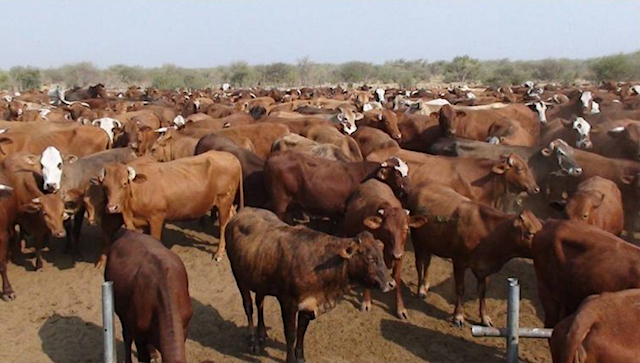THE Angolan market has taken up 5,5% more live cattle from Namibia by the end of September, compared to the same period last year.
This is according to the latest statistics of the Meat Board of Namibia (MBN).
The country in September and June together exported more than 300 live head of cattle to Angola.
By the end of September, Namibia has exported 1 430 head of cattle in total, compared to 1 355 in the same period last year.
South Africa accounted for the most (98,85%) of Namibia’s cattle exports, with Angola second.
Some 46 animals were exported to unknown destinations.
This puts the country in a vulnerable position in terms of its market structure as the reduction in imports from South Africa has quite a severe impact on local farmers.
The same can be said in terms of beef exports when it comes to the African market: South Africa dominates (with 1,03 million kg) followed by Botswana (646 762 kg), which takes up half of what SA procures.
Fortunately the international market came to the rescue of beef exports, diversifying the beef market with less dependence on one country.
The European Union, including Norway), was the top beef export destination, taking up 33,55% of total export volume, followed by South Africa and China with 28,62% and 15,78%, respectively.
Surprisingly, the country is still importing beef, but at the end of September this year, Namibia’s beef imports declined by 64,4% from 3,619 tonnes in the first three quarters of 2019 to 1,276 tonnes in the same period this year.
A total of 193 644 head of cattle were marketed through formal channels during the year until the end of September, which represents a 49,49% decline compared to 462 animals in 2019.
The decline is also a huge deviation from the country’s five-year average as it decreased by 41,08%, indicating a significant fall in the cattle sector.
This also raises further questions on how the country can de-risk the sector in terms of animal feed and other production input.
Desmond Cloete, chief marketing officer at NMB, says the reduction in the number of cattle marketed indicates the country is running out of raw material (cattle) as the cost of farming shoots up.
He says the increase in uptake by the Angolan market could signify an improvement in that country’s economy, which presents an opportunity for the Namibian cattle market.
However, it will be difficult with Namibia’s livestock decreasing significantly as shown by the number of cattle going to the market.
Cloete says thorough research is required to determine the various factors leading to dwindling numbers.
He says if the country does not start utilising dormant land, such as green schemes, to produce fodder and other needed supplements, it will continue to lose raw material or cattle to be marketed.
Earlier this year, the Namibia Agricultural Union 2020’s second-quarter agri-review showed the production cost index stood at 107,8 basis points in the second quarter of 2019, but increased to 109,9 basis points in the second quarter of this year.
The review showed producers continue to pay more for a basket of inputs used in the production of livestock than what they receive for livestock sold on the market.
The Meat Board also indicated some positive trends as cattle slaughtering north of the veterinary cordon fence (redline) has improved, while live cattle exports to neighbouring Angola and the slaughtering of goats for local consumption have also shown notable improvement.
Slaughtering north of the redline improved significantly by 50,31%, with 1 231 head of cattle slaughtered during the review period, while slaughtering south of the redline declined by 64,64%, resulting in a notable impact on the overall performance of the cattle sector. Export abattoirs north of the redline slaughtered 1 231 animals by the end of September this year, compared to 1 171 in the whole 2019.
The review indicated export activity has generally declined – not due to a fall in global consumption, but to lower meat production numbers in the country, mirroring the effects of the drought.
Stay informed with The Namibian – your source for credible journalism. Get in-depth reporting and opinions for
only N$85 a month. Invest in journalism, invest in democracy –
Subscribe Now!










